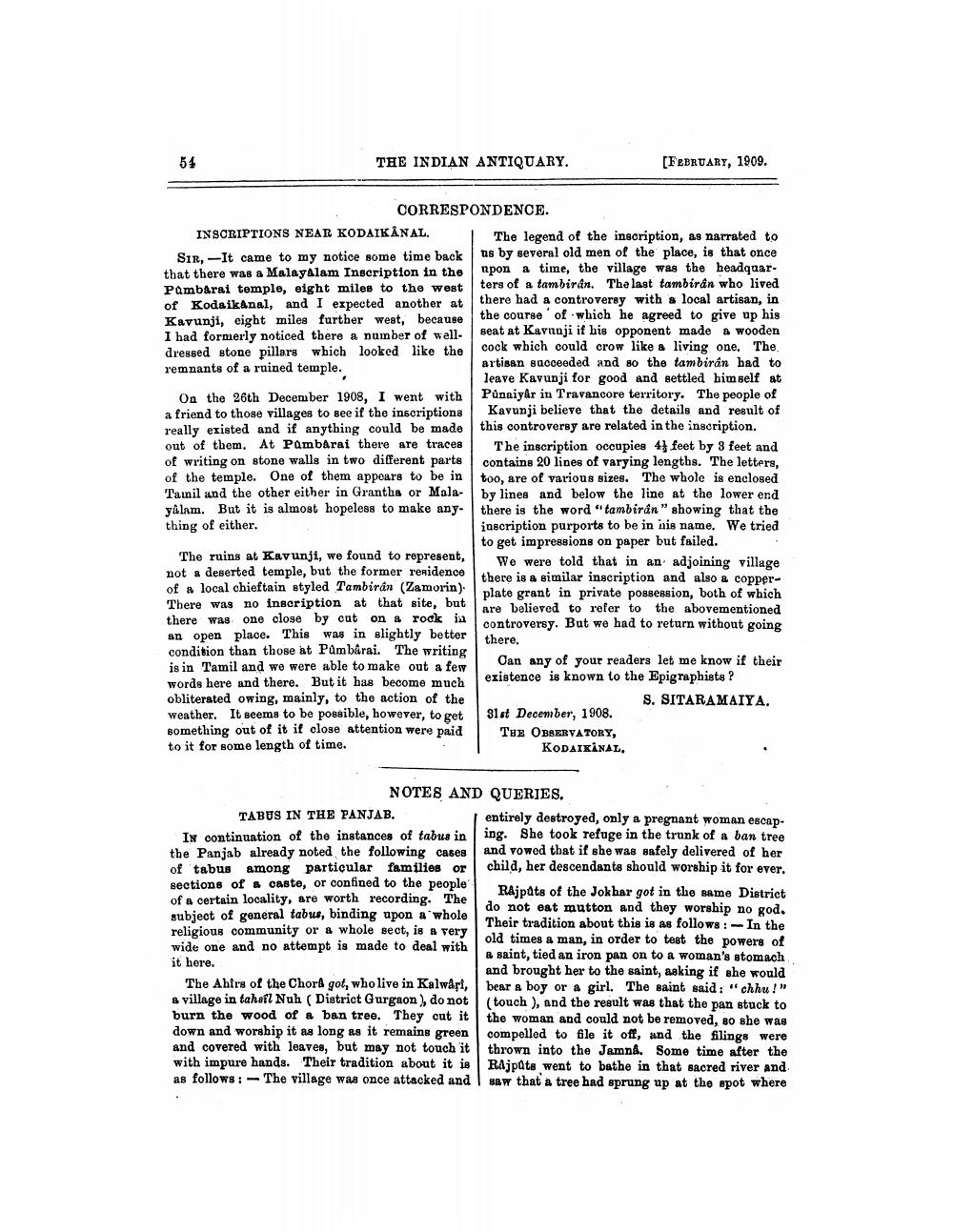________________
THE INDIAN ANTIQUARY.
[FEBRUARY, 1909.
CORRESPONDENCE. INSCRIPTIONS NEAR KODAIKÅNAL.
The legend of the inscription, as narrated to Sir, It came to my notice some time back us by several old men of the place, is that once that there was a Malayalam Inscription in the upon a time, the village was the headquarPambarai temple, eight miles to the west ters of a tambiran. The last tambiran who lived of Kodaikanal, and I expected another at
there had a controversy with a local artisan, in Kavunji, eight miles further west, because the course of which he agreed to give up his I had formerly noticed there a number of well
seat at Kavanji if his opponent made & wooden dressed stone pillars which looked like the cock which could crow like a living one. The remnants of a ruined temple.
artisan succeeded and so the tambirán had to
leave Kavunji for good and settled himself at On the 26th December 1908, I went with Punaiyâr in Travancore territory. The people of a friend to those villages to see if the inscriptions Kavunji believe that the details and result of really existed and if anything could be made this controversy are related in the inscription. out of them. At Pambarai there are traces The inscription occupies 4 feet by 8 feet and of writing on stone walls in two different parts contains 20 lines of varying lengths. The letters, of the temple. One of them appears to be in too, are of various sizes. The whole is enclosed Tainil and the other either in Grantha or Mala- by lines and below the line at the lower end yalam. But it is almost hopeless to make any there is the word "tambiran" showing that the thing of either.
inscription purports to be in nis name. We tried
to get impressions on paper but failed. The ruins at Kavunji, we found to represent,
We were told that in an adjoining village not a deserted temple, but the former residence
there is a similar inscription and also a copperof a local chieftain styled Tambiran (Zamorin)
plate grant in private possession, both of which There was no inscription at that site, but
are believed to refer to the abovementioned there was one close by cut on a rock in
controversy. But we had to return without going an open place. This was in slightly better
there. condition than those at Půmbarai. The writing is in Tamil and we were able to make out a few
Can any of your readers let me know if their words here and there. But it has become much existence is known to the Epigraphiste ? obliterated owing, mainly, to the action of the
S. SITARAMAIYA. weather. It seems to be possible, however, to get 31st December, 1908. something out of it if close attention were paid THE OBSERVATORY, to it for some length of time.
KODAIKANAL.
NOTES AND QUERIES. TABUS IN THE PANJAB.
| entirely destroyed, only a pregnant woman escapIn continuation of the instances of tabus in ing. She took refuge in the trunk of a ban tree the Panjab already noted the following cases and vowed that if she was safely delivered of her of tabus among particular families or child, her descendants should worship it for ever. sections of a caste, or confined to the people
Rajpate of the Jokhar got in the same District of a certain locality, are worth recording. The
do not eat mutton and they worship no god. subject of general tabus, binding upon a whole
Their tradition about this is as follows:- In the religious community or a whole sect, is a very
old times a man, in order to test the powers of wide one and no attempt is made to deal with
a saint, tied an iron pan on to a woman's stomach it here.
and brought her to the saint, asking if she would The Ahirs of the Chorâ got, who live in Kalwari, bear a boy or a girl. The saint said: "chhu!" a village in tahsil Nuh (District Gurgaon), do not (touch ), and the result was that the pan stuck to burn the wood of a ban tree. They cut it the woman and could not be removed, so she was down and worship it as long as it remains green compelled to file it off, and the filings were and covered with leaves, but may not touch it thrown into the Jamna. Some time after the with impure hands. Their tradition about it is Rajpdts went to bathe in that sacred river and as follows: The village was once attacked and saw that a tree had sprung up at the spot where




